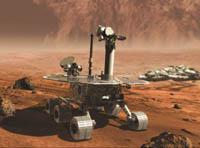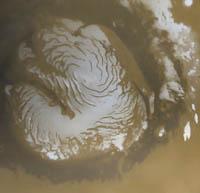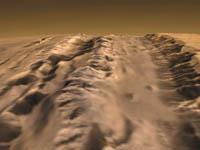Scott Hubbard: "Humans are explorers in themselves"

Has the NASA program on Mars changed recently?
At NASA headquarters, around March 2000, I was asked to lead the Mars program. It was known that there were problems with missions to Mars. Mars Climate Orbiter and Mars Polar Lander. I was asked to restructure the entire program.
What is your general approach?
Our focus is mainly on the scientific field. Our goal is to find answers to questions such as: Has there been life on Mars? Are you alive today? And now we are in the development phase of new missions.
In general, what will be the program of the coming years?
In 2003 two Rover will be sent to analyze the cover of Mars. Mars Pathfinder will be much larger than it was on mission. Since 2005 we want to design many new missions. We are now working to ensure international cooperation in all these missions. We have four main scientific objectives: the research of local life, the climate, the solid geology of the planet and the training so that human beings can carry out explorations.

For this we have organized the program called Follow the water. Water is essential to live. In any area of the world we have liquid water, energy, organic matter and, ultimately, live. The mission we have now geared to Mars, Mars Global Surveyor, is taking pictures in high definition. These photographs demonstrate the existence of "modern water". This means that water can be yesterday or a million years ago. Formerly it was thought that the water was far from the surface of the planet. We believe it can now be closer. Water can be about two hundred meters deep. Next April we will put in orbit another probe that looks for modern water. In addition, the possibility of using drilling techniques is being studied and it is possible that with these technologies some sessions will be held in our missions.
Later they will be the Rovers of 2003. In the coming years we will send numerous scanning tools. The use of planes and balloons has also been proposed. In the future we plan to bring samples of Mars. And later, NASA studies the possibility of sending individuals to Mars.
But before we have to solve four problems. The first is the cost problem. The second is transport technology. The third is a biomedical problem related to radiation and low gravity. And the fourth point is the reason for wanting to go. We believe that the best way to explore Mars is through people. Therefore, in the next decade there will be many missions to clarify if there is water on Mars and in the next time it will be time to study the possibility of sending human beings. Some dreamers believe that Mars can become our second home. But today this belongs to the realm of science fiction. It is mere speculation and we will analyze the science we can do in the next decade.
The canals seen in some pictures of Mars, supposedly remnants of water, we know them for a long time, were already seen in the Mariner 9 mission. What's new in recent photos?

Yes. The canals we have probably seen are those made by the watercourses. They carried water, but it could be 2,000 million years ago. The interpretation has changed at least because previously it was thought that water could be very deep. The current discovery is fascinating, as those we have seen this year can be modern water channels. We have gone from several kilometers deep to hundreds of meters in the new interpretation.
What degree of certainty is there in this conclusion?
The responsibility of science is to collect data and give interpretations. This way new questions can be asked. We said that in the last channels visited on Mars there was modern water. That is the best explanation for what has been seen. There will be something else. However, these channels are especially similar to the traces caused by the sudden flood of deserts, so the most critical opinions coincide. Therefore, one of the objectives that has been established is to analyze these areas more closely. The effects may be similar to those of rock slides, but the lines are not very well defined. The sand, as in the snowfalls, is scattered on the slopes. Therefore, they are considered to be a consequence of sudden flooding. The experts who have conducted this study are geomorphologists.
A combination of different methodologies will be used to confirm the presence of water. In the 2001 mission there may be some place where there is water. The Rovers sent in Mission 2003 would take them from orbit to chosen points. On the other hand, we are studying a new mission that could be launched from 2005 and that could be the search for sound waves. This technique is used by companies looking for oil.
Is there collaboration in these projects?

In 2003 a new mission will be launched in collaboration with a European group, called Mars express. American and Italian scientists will send the first robot to Mars. That will also give us information. We may have to do some drilling at some point.
When you talk about finding water you talk about life. But in the North Pole, for example, with a lot of water, there are no living beings...
We do not know beings who can live on the ice. Liquid water is essential. For example, Greenland is not green. (Translator's note: Greenland in English is "Greenland" and that literally means "green territory").
How will you analyze the atmosphere of Mars?
Through the mission of 2003, we want to clarify what was the climate of Mars in the past. Today it is a cold and dry desert that has lost most of its atmosphere. The work of these rover will consist of microscopic analysis of rocks. In this way we can know the climate depending on the minerals detected. Minerals can contain a lot or little water because they exchange water with the atmosphere.
Today we are in a situation after the Cold War. An important feature of the Apollo missions was to be involved in space competition against the Russians. Human exploration on Mars has very different motives. It's just my opinion, but there are two main reasons. First, that exploration is intrinsic to human beings, that is, we are explorers in themselves. And on the other hand, feel like answering the question of whether we are alone. If we found life on Mars, it would be very important news for everyone.
What if water is found on Mars and is not alive?
Answering this question is not easy. It is true that something cannot be demonstrated. But in many places and for much effort, if the answer remains negative, it is also a very important result.
Do you know the organisms that live in the acidic waters of the Red River?

Well, for a while I worked with Juan Pérez, director of the National Center of Marketing Astrobiology, and he informed me about the Tinto River. This information has expanded our knowledge of the limits of life. It is the hardest means in which there is life on Earth. Finding life on Earth in extreme conditions gives us the hope of finding life on planets like Mars, which is also a very harsh environment. The pH of the Red River and Mars are not the same, but finding life in such harsh conditions can mean that it is also on Mars, as its characteristics are very harsh.
What kind of experiment should be done to confirm that life has been found?
Finding life is a very complex task. I give you an example. There is no doubt that a meteorite was found from Mars. Those who did the analyses said there were fossilized bacteria and a great debate arose. This debate has not yet ended. But there is one clear thing: no one has a general definition of life. We look for the basic characteristics of our life, the fingerprints of life. Therefore, scientists like Juan Pérez Mercader try to study the chemistry and physics of life in order to build the sensors that robots will take to Mars. These sensors would look for the fingerprints of life. So we would know if there has ever been life in it. This is one of the main efforts of astrobiology.
What does it mean to find life? Finding proteins? Finding nucleic acids?
When we seek life within the Universe, we must be careful not to assume that it is similar to what is on Earth. Therefore, we are reflecting on basic chemistry and physics. On the other hand, we have developed very complex life measures. For example, we currently have DNA detectors. If we did not find DNA on Mars, the conclusion would be that we have not asked ourselves a proper question. Therefore, we seek basic things. We could look for amino acids and various types of chemistry, such as the chemistry of imbalance. This involves a certain process of transforming matter into energy. This can be a feature of life.
Do you want to seek self-replication?
Crystals self-replicate and are not considered alive. Therefore, in the general definition of life we can talk about self-replication, but it is very difficult to design a device capable of detecting it.
Buletina
Bidali zure helbide elektronikoa eta jaso asteroko buletina zure sarrera-ontzian











